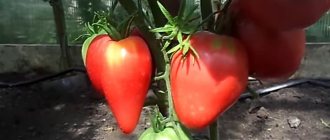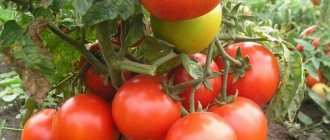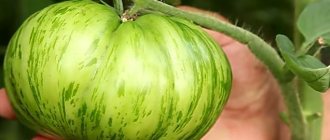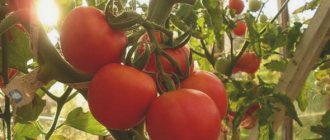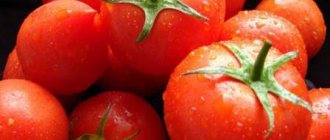It’s easy to guess which vegetable is the most popular in our country: of course, it’s the tomato! Breeders have developed a huge variety of tomato varieties with completely different characteristics. Some are more suitable for fresh salad, others for canning, freezing and long-term storage.
There are varieties that are used primarily for making juice. One of them is the Korneevsky tomato, named after a breeder famous in the eighties. Tomatoes with a bright pink color, juicy and sweet pulp have taken their rightful place in garden beds throughout Russia.
Description of the variety
The Korneevsky pink tomato belongs to tall and mid-season varieties. Fruits in mid-summer. It can be grown both in open ground and in greenhouses.
Reference. Plants grow taller outdoors than in greenhouse conditions.
Bushes with light green leaves, 140-160 cm high. The fruits are large, weighing up to 500 g, shaped like a rectangle. 8-15 tomatoes are harvested from one bush. On the lower branches, tomatoes grow weighing more than 900 g. The shoot itself has unlimited growth and can reach 2 m in height when grown in open ground.
How to grow seedlings
Before sowing, tomato seeds are checked in a saline solution and only those that have not floated half an hour after being immersed in the liquid are planted.
Important! Seeds are stored for two years. Do not use expired material for germination.
Planting is done in the ground with the addition of garden soil. The earth is disinfected in advance by calcining it in the oven. The seeding depth is 1.5-2 cm. Before the first sprouts appear, the home garden bed is covered with transparent polyethylene.
Compliance with the basic rules ensures good seed germination and strong seedlings:
- maintaining the temperature at 20-22 degrees;
- good lighting;
- timely watering;
- carrying out picking after the appearance of the first true leaves;
- hardening of seedlings 10 days before planting on the site.
Growing
The optimal growing method is seedlings. In early or mid-March, the seeds are disinfected with a solution of potassium permanganate and soaked in a growth stimulator. This increases the germination percentage. Earth mixed with humus is brought from a summer cottage and calcined in the oven. Store-bought soil does not require pre-treatment.
Warmth is needed for seedlings to emerge. Optimum temperature +25˚С. Young shoots need partial shade and a temperature range of 15–18˚C. Grown bushes are placed in a sunny place after about a week. Water, loosen, illuminate with a phytolamp on cloudy days. In the phase of 1–2 true leaves, pick and first fertilize.
Growing tomatoes
2-2.5 months after the appearance of the first shoots, the bushes are planted in open ground or a greenhouse.
Important! The Korneevsky tomato is afraid of frost and may die from it. Therefore, in May the plant can only be planted in a greenhouse, and outside in June.
The bushes of this variety are spreading; it is necessary to think through the planting scheme in advance. The holes are dug at a distance of at least 30 cm from each other so that adult plants do not interfere with their neighbors.
Before planting, add a little compost or manure to each hole and mix it with the soil - this is how the tomatoes are fed for the first time. Organic fertilizers are reused during flowering and fruiting. Tomatoes are fertilized with organic fertilizers to maintain soil composition and enhance the activity of microorganisms. This is an accessible and inexpensive method that is safe for humans.
As the bush grows, side branches - stepsons - appear from the axils of the leaves. To ensure rational use of nutrients by the plant, useless elements are removed. Timely pinching leads to increased productivity.
To ensure that the load on the branches is uniform, a bush is formed from two trunks, removing the lower leaves and side stems, and pinching is carried out. The powerful root system and thick branches hold clusters of heavy fruit well.
As they grow, during the period of active growing and flowering, the plants are tied up and, if necessary, supports are placed. During fruiting, this helps the branches to withstand the load and not break.
Landing
Korneevsky tomato seeds are sown in mid-March. They are disinfected in advance with potassium permanganate, and to stimulate germination they are soaked for 8–10 hours in Zircon or Agate.
The depth of the backlog is 1 cm, indentations are made every 2–3 cm.
The containers used are pots, peat tablets, and boxes with a side (8–10 cm). After planting, the containers are covered with agrofibre and film. The boxes are moved to a warm place (with a temperature of 25–27 degrees). After germination, the shelter is removed, and the seedlings are kept in cool conditions (15–16 degrees) for 7–10 days.
How to care:
- irrigate through a spray bottle 2-3 times a week;
- fed with nitrogen compounds, manure solutions, and bin infusions;
- pick at the two-leaf stage and plant in separate containers;
- harden off by placing the seedlings in a cool place.
Features of growing in a greenhouse and open ground
When cultivating in open space, special attention is paid to tying, since the bushes stretch higher than in greenhouses, and the weight of the fruit can reach a kilogram.
The variety is resistant to many diseases, but there are diseases that can affect plants. With excess moisture, especially in greenhouse conditions, apical or root rot develops. This can be easily avoided by following the watering schedule and ensuring regular ventilation of the room.
Important! When growing tomatoes, do not forget to loosen the soil and remove weeds. Before flowering, treat young plants with insecticides. This will ensure active growth of shoots and protect against late blight.
Diseases and pests
Despite the fact that the variety is resistant to most diseases, preventive measures are recommended. Before planting seedlings, it is worth watering the soil with hot potassium permanganate.
It is recommended to periodically loosen the soil - this will help prevent root rot from developing. Mulching is also performed using peat or humus. To protect the plant from late blight, spray with preparations with a high copper content.
Read also: Tomatoes in gelatin recipes for the winter step by step with photos
Industrial insecticides are usually used to control pests. You can also use herbal infusions of celandine, chamomile or yarrow. They will cope perfectly with spider mites, thrips, nematodes and whiteflies.
Tomato Korneevsky is an excellent choice for growing tomatoes on your site. Thanks to its unpretentiousness, care will not take you much time, but at the same time you will get a tasty and rich harvest.
Harvesting and application
The Korneevsky pink variety tolerates transportation well and is suitable for long-term storage. You can enjoy the taste of harvested tomatoes before the onset of cold weather. Up to 9 kg of crop is harvested from each bush.
Reference. The Korneevsky tomato is harvested at the moment of technical maturity for successful transportation. At home, it ripens successfully.
Fragrant, sweet, fleshy tomatoes are used to make juice, ketchup, adjika, and lecho. The variety is suitable for freezing: its fruits are dense and not at all watery.
The size of the tomatoes does not allow them to be canned whole in jars: they do not fit into the neck. Experienced housewives pickle tomatoes in barrels or large enamel containers and store the pickles in the cellar all winter.
Advantages and disadvantages
The only drawback of the Korneevsky variety is the need to strengthen the bush. It is necessary to install supports for branches that are loaded with heavy bunches of tomatoes.
There are many more advantages:
- presentation of tomatoes;
- taste qualities of fruits;
- long shelf life;
- ability to withstand transportation well over long distances;
- high yield.
Tomato Korneevsky pink for those who love large tomatoes
Good afternoon, dear summer residents! The topic of tomatoes is endless, especially when we talk about the variety of varieties. And it seems that many have caught themselves wanting to plant some unusual tomato, which will delight not only with its yield, but also with its original appearance.
The Korneevsky pink tomato, a description and photo of which will be presented to you, delights with its excellent characteristics and at the same time it is very attractive. It is not surprising that many gardeners in different regions grow this pink giant.
Reviews from gardeners
Summer residents talk about the Korneevsky variety as one of the most aromatic and tasty.
Sweet-tasting, large, fleshy and weighty fruits will decorate any garden bed. Alexander: “My favorite variety of tomatoes since childhood is Korneevsky rectangular.
Ripe fruits are very juicy, sweet and fleshy. Harvesting is a pleasure. One tomato can weigh up to 800 g. Tomatoes are not suitable for canning. Ripe fruits make excellent salads and tomato juice. It stores well, so you can pamper yourself with healthy and tasty tomatoes for a long time. The promised characteristics of the variety correspond to reality. I am continuing the family tradition and have been planting my favorite tomato for the second year now.” Lyudmila: “Korneevsky is my favorite variety of tomatoes. I can’t say that it’s low-yielding. I only have three bushes, and for two weeks now that’s all we’ve been eating. I water it rarely until they crack. The taste is not the sweetest, but very rich and balanced.”
Angelina: “The fruits of Korneevsky pink are flat and large. For me this is the standard of the best taste. But they always crack at the top, 3-5 fruits ripen on the bush, that is, the variety is low-yielding and not for the market.”
Tomato variety Korneevsky on video
If you grew tomatoes of the Korneevsky variety, please write whether you liked them or not. What was the yield and taste of the fruits in your climatic conditions? Will you grow them again? Briefly describe the advantages and disadvantages of this tomato in your opinion. If possible, attach to the comment a photo of the entire bush as a whole or individual fruits that you grew. Thank you!
Your reviews of the Korneevsky tomato variety and additions to the description will help many gardeners evaluate this variety more objectively and decide whether it is worth planting or not.
This is a natural variety of tomato. Therefore, we recommend taking seeds from a ripe fruit and using them for planting in subsequent seasons.
